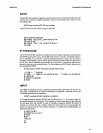
BASIC-SO
Commands
and
Statements
In the example below, LIST
30
prints line
30
only; LIST -30 prints all lines up
to
and
including
30; list 30- prints all lines after 30, including
30;
LIST 30-50 prints lines 30,
40,
and 50; LIST prints the entire program text.
10
PRINT CHR$(12)
20
INPUT
A,B,C
30
PRINT (A + B + C)/3
40
PRINT
50
END
LIST
30
30
PRINT(A+B+C)/3
LlST-30
10
PRINT CHR$(12)
20
INPUT
A,B,C
30
PRINT(A+B+C)/3
LIST 30-
30
PRINT
(A+
B+C)/3
40
PRINT
50
END
LIST
30-50
30
PRINT (A + B + C)/3
40
PRINT
50
END
LIST
10
PRINT CHR$(12)
20
INPUT
A,B,C
30
PRINT
(A
+ B + C)/3
40
PRINT
50
END
To
obtain a listing
of
a file on a line printer
or
other device, use the SAVE com-
mand, which
is
described on page 6-22.
LOAD
The LOAD command reads a file from disk and stores it
in
memory, making it the
current file. The string expression must be an
ISIS-II filename.
LOAD
filename
LOAD"
:F1:
PLOT"
OK
RUN
THIS PROGRAM PLOTS
ANY
USER-DEFINED
FUNCTION ON
AN X-Y
GRAPH.
LSET,
RSET
The LSET and RSET statements store the specified string expression into string
space
that
has been allocated in a random file buffer by a FIELD statement. When
string variables are assigned to a random file buffer with the FIELD statement, they
6-11


















